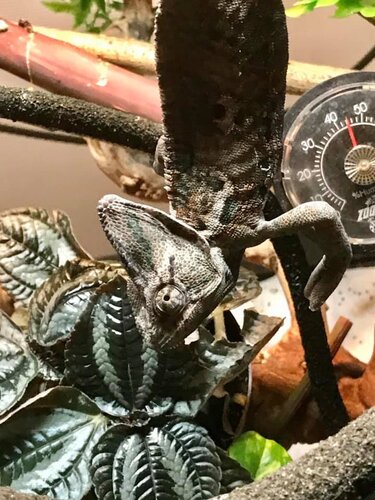CasqueAbove
Chameleon Enthusiast
Often when we think of plants for our chameleons, we are thinking in terms of safety, hiding places, and overall trying to give a natural appearance.
However plants play a far bigger role. Without going into the full process, we know that plants can absorb water and move it to its leaves and stems. The basic way this works is that as water molecules evaporate from the leaves. Because water molecules are slightly polar (like a magnet) this evaporation process pulls on the next water molecule, and that pulls on the next and on down the line. Why do we care about this? Well it is that very process that is putting water molecules into the air, thus increasing humidity.
If we try to increase humidity with just substrate, the bottom may register slightly higher, but the pull of gravity on the water molecules keeps them on the bottom. A plant on the other hand, can over come gravity and move the water to its leaves, thus spreading the molecules throughout the enclosure. This is why it can be so difficult to keep humidity up in a cage with few or no live plants, and seems to just be easy in a bioActive.
My thoughts,
Different plants will have different evaporation, water needs, so looking for plants that have high water demands should aid in higher create more humidity?
I have seen many put plastic or sorts on screen cages to aid humidity. I was wondering how effective it would be to keep large bushy plants on the outside of the cage, but right up next to it. Maybe one one either side ? Could this be an option for some?
However plants play a far bigger role. Without going into the full process, we know that plants can absorb water and move it to its leaves and stems. The basic way this works is that as water molecules evaporate from the leaves. Because water molecules are slightly polar (like a magnet) this evaporation process pulls on the next water molecule, and that pulls on the next and on down the line. Why do we care about this? Well it is that very process that is putting water molecules into the air, thus increasing humidity.
If we try to increase humidity with just substrate, the bottom may register slightly higher, but the pull of gravity on the water molecules keeps them on the bottom. A plant on the other hand, can over come gravity and move the water to its leaves, thus spreading the molecules throughout the enclosure. This is why it can be so difficult to keep humidity up in a cage with few or no live plants, and seems to just be easy in a bioActive.
My thoughts,
Different plants will have different evaporation, water needs, so looking for plants that have high water demands should aid in higher create more humidity?
I have seen many put plastic or sorts on screen cages to aid humidity. I was wondering how effective it would be to keep large bushy plants on the outside of the cage, but right up next to it. Maybe one one either side ? Could this be an option for some?




